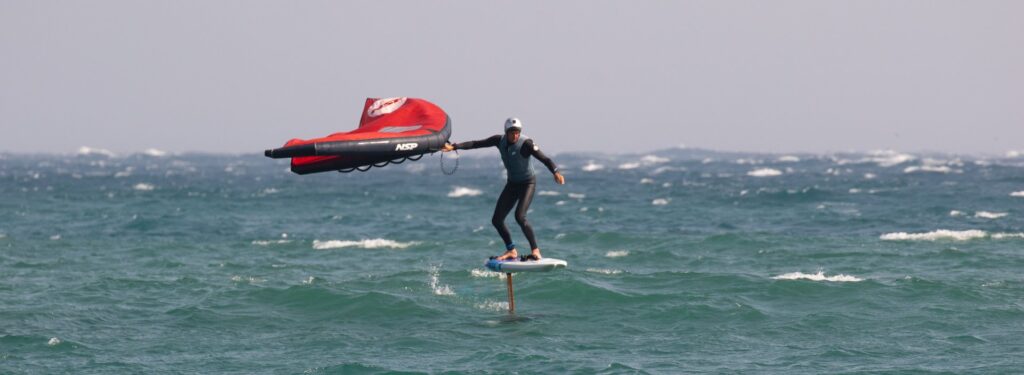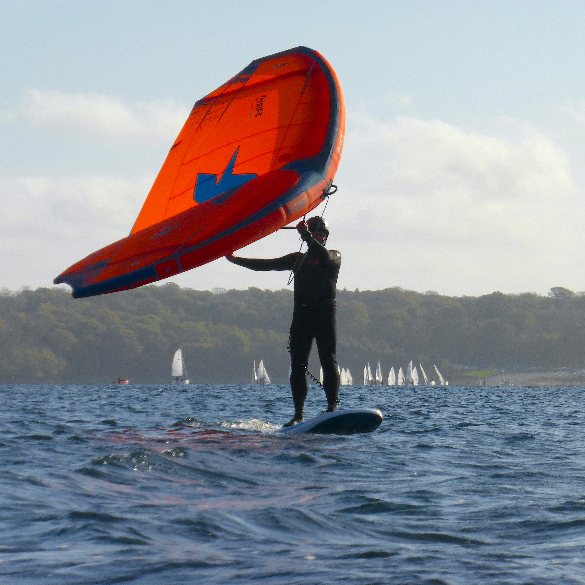How to choose the right wing foil equipment for beginners
On this page we go into the subject of wingfoil equipment for beginners: what to start off with. Starting your journey in wingfoiling is exciting. Picking the right equipment is key. Every new wingfoiler is unsure about this choice and it may feel like you are committing to something that you don’t know works for you. No worries, there is a lot of movement on the second-hand market so in case you feel you didn’t pick the right beginner set, you will probably be able to sell it and modify your wingfoil quiver.
Wingfoiling combines elements of surfing, windsurfing, and kitesurfing. It requires specific equipment: a wing, a board, and a hydrofoil. Each piece plays a crucial role. This guide will help beginners understand what to look for in wingfoil gear when you start.

The biggest mistake you want to avoid is buying advanced, expensive gear when you start. The reason for is the following. Wingfoil equipment for beginners should be easy to handle, fly at low speed, offer stability and forgive your mistakes. This will not happen if you buy a pro set. Adanced wingfoil equipment is built for speed, quick moves, bigger thrills, jumping and feisty rides. But you are not that person yet! Do not think that advanced equipment allows you to learn how to wingfoil. What allows you to learn is easy equipment and that is not the same thing.

Yes – this guy also started with a beginner set.
Choosing a wing
The wing is your power source. For beginners, look for a wing that is easy to handle and stable. A size between 4 to 6 square meters works well for most.
Bigger wings are not always better, rigidity is also very important. A more rigid wing responds better to the wing, gives you a more direct feeling of response but also requires more wing control capacity of the rider.
Larger wings offer more power, but can be harder to control. Try the wing out on land and see if you like how it feels.
Getting a wingfoil board
Your board is your platform. Beginners should choose a larger, wider board for stability. The volume of the board is important too. Higher volume means more buoyancy, which helps with balance.
Take a a basic rule: your weight plus around 30 to 40 kilos is the volume in litres that you want.
Consider getting an inflatable board, as they are a lot more friendly to the knees and the body if you fall on them.

The board
Give priority to a stable, big board for your first months of wingfoiling. This allows you to focus on managing the wing, learning how to pump and taking off.
After you learn all that, you can scale down on board size. There is a lot of second hand trading going on, so you’ll be fine.
Hydrofoil: getting the lift
The hydrofoil lets you rise above the water. A beginner-friendly foil has a larger front wing for stability and smoother lift. Look for a foil that’s easy to maneuver. When faced with the choice of high aspect or low aspect foil, choose a low aspect foil. A low aspect foil is bigger, slower and has rounder edges. This will protect you better if you fall and hit it. The bigger size will allow for earlier flight at lower speed, which is good for learning. For your reference, below you see two examples.

This is a low aspect wing. It will fly at low speeds, offer stability and it forgives mistakes. Don’t worry about the wing being boring, the whole deal with flying above the water will blow your mind.

This is a high aspect wing. Great for exciting, thrilling rides, quick moves and manoeuvrability! Not for beginners though, as the wing demands a higher skill level.
So… that’s all great, but what do I start with then?
Let’s say you are a big guy or girl, over 1.80 meters and over 85 kilos.
You may want to start with a 140 liters board, a foil with a front wing of 2100-2400 cm2 and a 6,5 meters wing. This will allow you to learn when there is 15 to 20 knots of wind and flat water. If your weight is more towards 85 kilos, consider getting out there with a 148-150 liters board.
Let’s say you you weigh in at 70 kilos and you’re around 1.70.
In that case, a 110 liters board would be a good start. Get a 6 meters wing and you are off at 14-15 knots.
Some more considerations about wing foil equipment for beginners
- Wind and water conditions
Going out in the right conditions is very important. The water needs to be flat and the winds should be strong enough. Read more about wind and water conditions for wingfoil. - Durability and quality
Quality matters. Durable equipment lasts longer and is safer. Don’t compromise on quality for price. Good equipment is an investment in your safety and progress. - Safety gear
Wingfoil safety comes first. Always wear a helmet and an impact vest. These protect you from falls and collisions. - Price range
Wingfoil equipment can be pricey. Set a realistic budget. Remember, good quality gear doesn’t have to break the bank. Look for deals and package options. - Try before you buy
If possible, try different equipment. Many schools offer rental gear. This helps you understand what suits you best. - Where to buy
Buy from reputable dealers. They offer warranties and support. Online forums and reviews can guide your choices. Also see our wingfoil brands section for an overview of different (not all) wingfoil brands out there. - Maintenance and care
Look after your gear. Proper maintenance increases its lifespan. Rinse with fresh water after use and store in a cool, dry place. See our maintenance tips here.
Key takeaways for beginner wing foilers
- Choose a stable and manageable wing.
- Opt for a larger, higher volume board for better balance.
- Select a hydrofoil designed for beginners.
- Invest in quality and durability.
- Never compromise on safety gear.
- Set a budget but prioritize quality.
- Try equipment through rentals before purchasing.
- Buy from reputable sources and consider package deals.
- Maintain your gear well for longevity.
- Consider buying second hand.
Conclusion: The right start with the right gear
Starting with the right equipment sets you up for success in wingfoiling. It’s not just about buying gear; it’s about choosing tools that help you learn and enjoy the sport. Remember, having the right wingfoil equipment for beginners is about finding that perfect balance between quality, functionality, and safety. With the right gear, the world of wingfoiling opens up with endless possibilities for fun and adventure.
